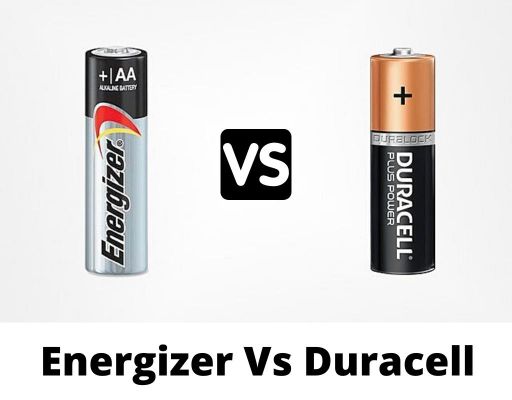The size and current capacity (or power capacity) of these two batteries are the most significant differences.
An AA battery has a capacity of 2.5 AH, whereas a D battery has a capacity of 12 AH. D batteries are nearly three times the diameter and somewhat longer than AA batteries.
They are used in a variety of ways. AA batteries are thinner than D batteries and are used in remote controls, clocks, toys, and other electronic devices. D batteries, on the other hand, are commonly used in torch lights.
In this post, I will dive to the depth and explore the optimal use cases. By the end you will have greater understanding of the Difference between AA and D batteries.
What are AA batteries?
The letters on a battery indicate the battery’s height and width. “50.5mm x 14.5mm” is what AA stands for. The bigger the battery, the later the letter is. AA batteries are one of the most widely used forms of interchangeable power cells today.
They’re what most of us imagine when we think of a basic replaceable battery’s ‘classic’ size and form. AA batteries are very adaptable and easily available practically everywhere in the globe and are frequently used in single-cell devices or pairs to power bigger but still reasonably compact consumer goods.
Advantages of AA batteries
High energy density:
AA batteries have a higher energy density than other types of batteries. An AA battery, for example, has twice the energy density of a zinc-carbon battery.
As a result, alkaline cells and batteries can provide the same amount of energy while lasting longer than other batteries.
Personal and environmental safety:
The chemicals in an AA battery do not offer severe health dangers when compared to lead-based and acid-based batteries.
In the worst-case scenario, the substances may cause minor irritations. Furthermore, alkaline batteries do not require special disposal and have a lower environmental impact.
Minimal leakage risk:
When compared to other batteries, AA batteries are far less prone to leakage.
Low-temperature operation:
When compared to other battery chemistries, alkaline batteries can operate at very low temperatures. In tough, cold-weather climates, this gives them an advantage.
Disadvantages of AA batteries
- They’re a little bigger than their lithium-ion counterparts.
- When charged with a malfunctioning charger, they have the potential to explode.
- They can leak a corrosive liquid over time, causing damage to the equipment they’re attached to.
- Their substances are poisonous.
- Their internal resistance is substantial, which reduces production.
What are D batteries?
D batteries are a common ‘dry cell’ battery size. These are the widely used interchangeable models in electronic and household equipment.
The word ‘dry cell’ is used to differentiate them from more specialized ‘wet cell’ batteries, which include liquid as the name implies.
D batteries are typically used in high-drain applications that require a long run time. Including, flashlights, automatic odorizers, paper towel dispensers, transmitters, radio receivers, etc.
Advantages of D batteries
- Can deliver more current than any other zinc-carbon battery.
- It is possible for a D cell to be rechargeable or non-rechargeable.
- Its terminal voltage and capacity are determined by the chemistry of its cells.
- D cells are ideal for applications that require a lot of current drains.
Disadvantages of D batteries
- Bulkier Form Factor.
- High Internal Resistance.
- Leakages and Damages.
- Unfriendly in terms of the environment.
- Discharge current is restricted.
Difference between AA and D batteries
The only actual difference is the size of the batteries, with AA batteries being significantly smaller than D batteries.
The chemistry is nearly identical. That is to say, the current competence will not be greatly enhanced, but the capacity will be expanded.
Both batteries have the same voltage of roughly 1.5 volts. When fully charged, the voltage drops to roughly 1V when exhausted.
A comparison table is provided below to show which one you require based on your requirements.
A Comparison Chart
| AA battery | D Battery | |
| Nominal Voltage | 1.5 volts | 1.5 volts |
| Rated Capacity | 2.870 mAh | 17000 mAh |
| Cut-off Voltage | 0.8 volts | 0.8 volts |
| Rated Load | 75 Ohm | 39 Ohm |
| Discharge C-rate | 0.007 | 0.0022 |
| Pricing | Lower | Higher |
Actually, it is debatable. Voltage and current are the two most significant factors.
Some electrical gadgets require a lot of current but not a lot of voltage to operate. This is when the battery size comes into play.
The D-size battery has a higher current output than the AA-size battery.
So, even if both an AA and a D battery have a voltage rating of 1.5, the D battery will deliver greater current than the AA battery.
Can I use AA batteries instead of D?
Because it runs at the same voltage as a D battery, one AA might accomplish the job electrically.
However, combining four AA batteries into a single battery to imitate the size of a D battery and effectively replace it proved easy.
Which one has a greater life span between D vs AA batteries?
A D battery can provide six times the amount of backup as an AA battery.
An AA battery can last 6 hours and 28 minutes on a 200 mAh battery.
Whereas a D battery can last 36 hours and 3 minutes. It also demonstrates that size does important.
Bottom Line
So, what are the Difference between AA and D batteries? There aren’t many distinctions between an AA and a D-size battery. Although the key distinctions between these two versatile batteries have been demonstrated.
However, it is entirely dependent on how it is used. They are available in a variety of sizes, colors, and pricing.
AA batteries have a smaller energy reserve depending on the brand, whereas D batteries have a much higher reserve, depending on the brand.
You’ll get 1.5 volts from an AA battery, but it won’t have the same energy density as a D battery. Thus, it won’t last as long under the same power consumption. So, I believe we’ve cleared up any confusion.
Related Posts:


